
| Version | Summary | Created by | Modification | Content Size | Created at | Operation |
|---|---|---|---|---|---|---|
| 1 | Sirius Huang | -- | 1726 | 2022-10-20 01:43:32 |
Video Upload Options
Marine algae and plants are a diverse collection of marine life that, together with cyanobacteria, form the main primary producers at base of the ocean food chain. Marine primary producers are important because they underpin almost all marine animal life by generating most of the oxygen and food that animals need to exist. Some algae and plants are also ecosystem engineers which change the environment and provide habitats for other marine life. Marine algae includes the largely invisible and often unicellular microalgae, which together with cyanobacteria form the ocean phytoplankton, as well as the larger, more visible and complex multicellular macroalgae commonly called seaweed. Seaweeds are found along coastal areas, living on the floor of continental shelves and washed up in intertidal zones. Some seaweeds drift with plankton in the sunlit surface waters (epipelagic zone) of the open ocean. Back in the Silurian, some phytoplankton evolved into red, brown and green algae. These algae then invaded the land and started evolving into the land plants we know today. Later in the Cretaceous some of these land plants returned to the sea as mangroves and seagrasses. These are found along coasts in intertidal regions and in the brackish water of estuaries. In addition, some seagrasses, like seaweeds, can be found at depths up to 50 metres on both soft and hard bottoms of the continental shelf.
1. Primary Producers

Primary producers are the autotroph organisms that make their own food instead of eating other organisms. This means primary producers become the starting point in the food chain for heterotroph organisms that do eat other organisms. Some marine primary producers are specialised bacteria and archaea which are chemotrophs, making their own food by gathering around hydrothermal vents and cold seeps and using chemosynthesis. However most marine primary production comes from organisms which use photosynthesis on the carbon dioxide dissolved in the water. This process uses energy from sunlight to convert water and carbon dioxide[1]:186–187 into sugars that can be used both as a source of chemical energy and of organic molecules that are used in the structural components of cells.[1]:1242 Marine primary producers are important because they underpin almost all marine animal life by generating most of the oxygen and food that provide other organisms with the chemical energy they need to exist.
The principal marine primary producers are cyanobacteria, algae and marine plants. The oxygen released as a by-product of photosynthesis is needed by nearly all living things to carry out cellular respiration. In addition, primary producers are influential in the global carbon and water cycles. They stabilize coastal areas and can provide habitats for marine animals. The term division has been traditionally used instead of phylum when discussing primary producers, although the International Code of Nomenclature for algae, fungi, and plants now accepts the terms as equivalent.[2]
1.1. Cyanobacteria
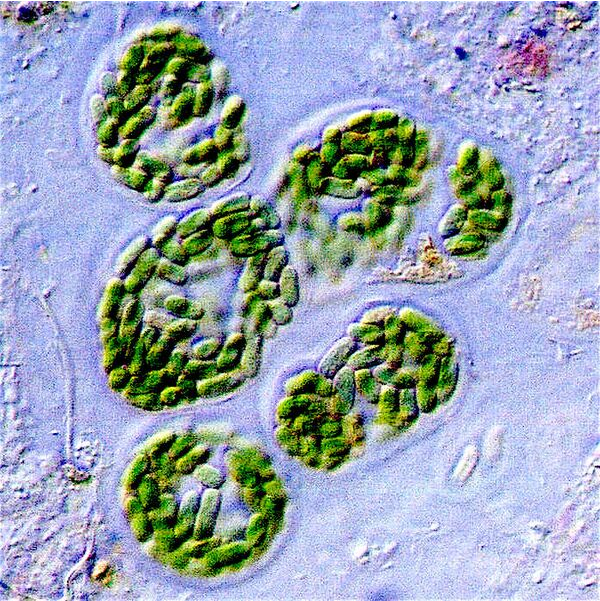
Cyanobacteria are a phylum (division) of bacteria which range from unicellular to filamentous and include colonial species. They are found almost everywhere on earth: in damp soil, in both freshwater and marine environments, and even on Antarctic rocks.[3] In particular, some species occur as drifting cells floating in the ocean, and as such were amongst the first of the phytoplankton.
The first primary producers that used photosynthesis were oceanic cyanobacteria about 2.3 billion years ago.[4][5] The release of molecular oxygen by cyanobacteria as a by-product of photosynthesis induced global changes in the Earth's environment. Because oxygen was toxic to most life on Earth at the time, this led to the near-extinction of oxygen-intolerant organisms, a dramatic change which redirected the evolution of the major animal and plant species.[6]

The tiny marine cyanobacterium Prochlorococcus, discovered in 1986, forms today part of the base of the ocean food chain and accounts for more than half the photosynthesis of the open ocean[7] and an estimated 20% of the oxygen in the Earth's atmosphere.[8] It is possibly the most plentiful genus on Earth: a single millilitre of surface seawater may contain 100,000 cells or more.[9]
Originally, biologists thought cyanobacteria was algae, and referred to it as "blue-green algae". The more recent view is that cyanobacteria is a bacteria, and hence is not even in the same Kingdom as algae. Most authorities exclude all prokaryotes, and hence cyanobacteria from the definition of algae.[10][11]
2. Marine Algae
Algae is an informal term for a widespread and diverse group of photosynthetic eukaryotic organisms which are not necessarily closely related and are thus polyphyletic. Unlike higher plants, algae lack roots, stems, or leaves. Marine algae mainly fall into five groups: green algae, red algae, brown algae, diatoms and dinoflagellates. There is also a phylum of unicellular flagellates called euglenophytes. However, these have few marine members.
2.1. Green Algae
Green algae live most of their lives as single cells or are filamentous, while others form colonies made up from long chains of cells, or are highly differentiated macroscopic seaweeds. They form an informal group containing about 8,000 recognized species.[12]
2.2. Red Algae
Modern red algae are mostly multicellular with differentiated cells and include many notable seaweeds.[13][14] As coralline algae, they play an important role in the ecology of coral reefs. They form a (disputed) phylum containing about 7,000 recognized species.[13]
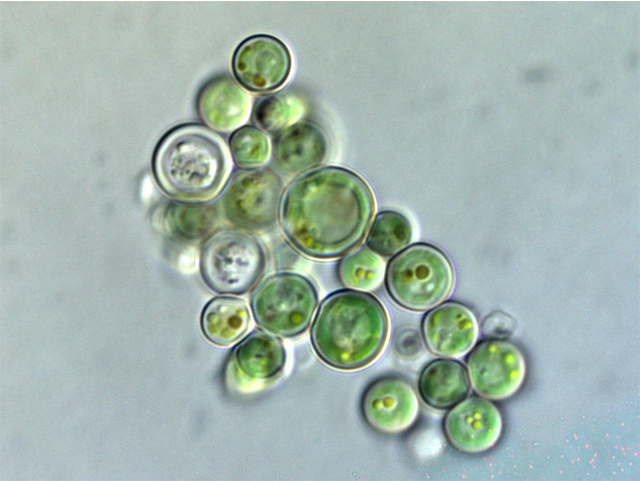
Cyanidiophyceae colony, a class of unicellular red algae https://handwiki.org/wiki/index.php?curid=1780293
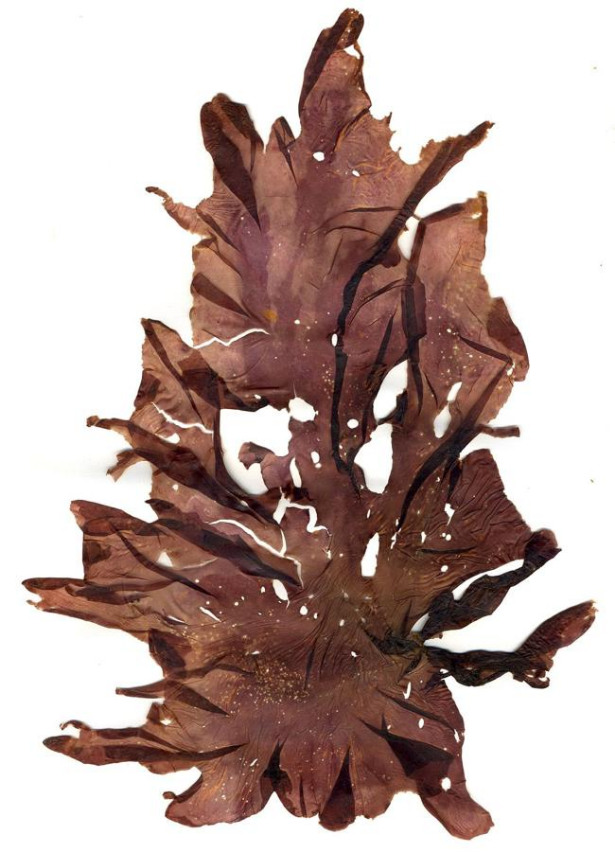
The seaweed Porphyra umbilicalis. https://handwiki.org/wiki/index.php?curid=1124931
2.3. Brown Algae
Brown algae are mostly multicellular and include many seaweeds, including kelp. They form a class containing about 2,000 recognized species.[15]
2.4. Diatoms
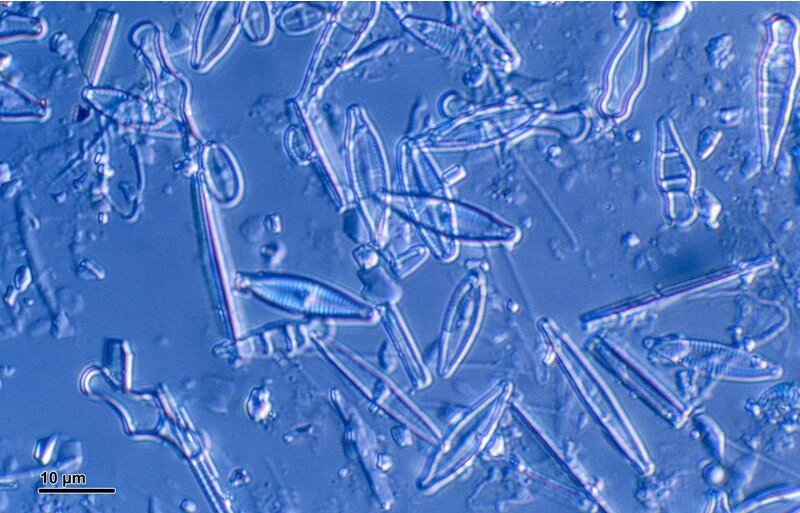
Diatoms are one of the most common types of phytoplankton. https://handwiki.org/wiki/index.php?curid=1596881

They are a major algae group generating about 20% of world oxygen production.[16] https://handwiki.org/wiki/index.php?curid=1747164
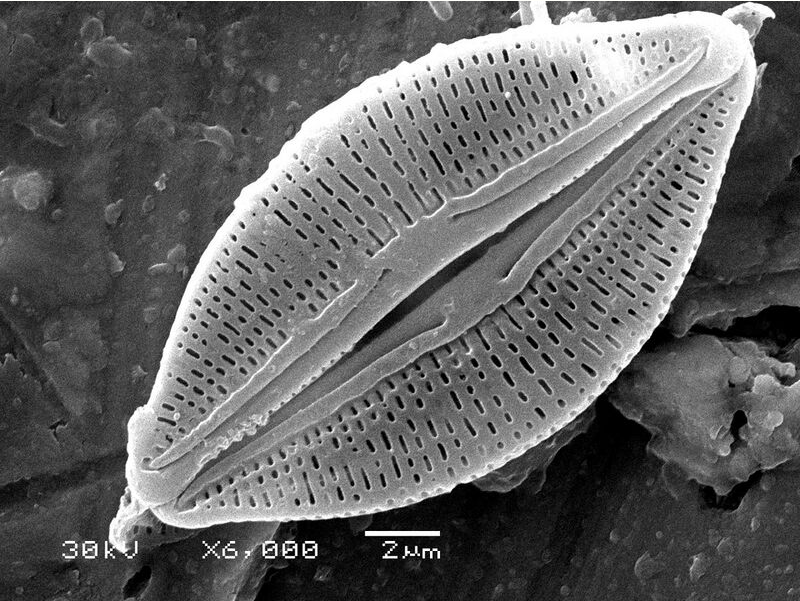
Diatoms have glass like cell walls called frustules which are made of silica.[17] https://handwiki.org/wiki/index.php?curid=1735075
2.5. Dinoflagellate

Dinoflagellates. https://handwiki.org/wiki/index.php?curid=1355933

Euglena mutabilis, a photosynthetic flagellate. https://handwiki.org/wiki/index.php?curid=1834299
2.6. Microalgae
Algae can also be classified by size as microalgae or macroalgae. Microalgae are the microscopic types of algae, not visible to the naked eye. They are mostly unicellular species which exist as individuals or in chains or groups, though some are multicellular. Microalgae are important components of the marine protists, as well as the marine phytoplankton. They are very diverse. It has been estimated there are 200,000-800,000 species of which about 50,000 species have been described.[18] Depending on the species, their sizes range from a few micrometers (µm) to a few hundred micrometers. They are specially adapted to an environment dominated by viscous forces.
- Microalgae
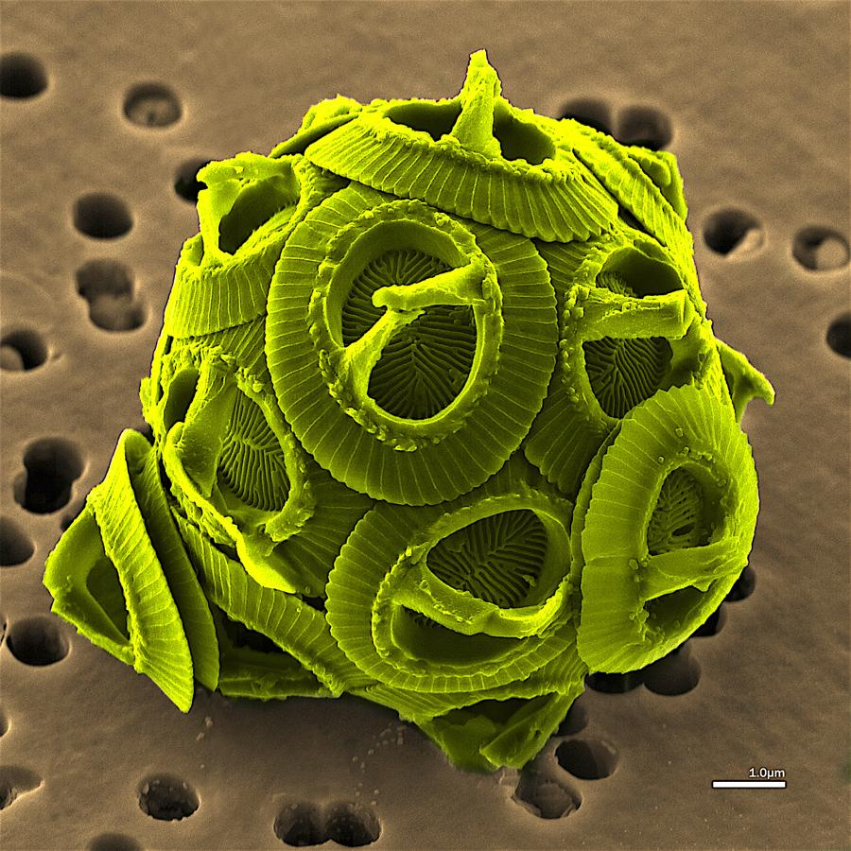
Single-celled alga, Gephyrocapsa oceanica. https://handwiki.org/wiki/index.php?curid=1222090

The coccolithophore Emiliania huxleyi. https://handwiki.org/wiki/index.php?curid=1576044

Algae bloom of Emiliania huxleyi off the southern coast of England. https://handwiki.org/wiki/index.php?curid=1876970

Zooxanthellae is a photosynthetic algae that lives inside hosts like coral. https://handwiki.org/wiki/index.php?curid=1580816

A single-celled ciliate with green zoochlorellae living inside endosymbiotically. https://handwiki.org/wiki/index.php?curid=1664974
2.7. Macroalgae

Macroalgae are the larger, multicellular and more visible types of algae, commonly called seaweeds. Seaweeds usually grow in shallow coastal waters where they are anchored to the seafloor by a holdfast. Seaweed that becomes adrift can wash up on beaches. Kelp is a large brown seaweed that forms large underwater forests covering about 25% of the world coastlines.[19] They are among the most productive and dynamic ecosystems on Earth.[20] Some Sargassum seaweeds are planktonic (free-floating). Like microalgae, macroalgae (seaweeds) are technically marine protists since they are not true plants.
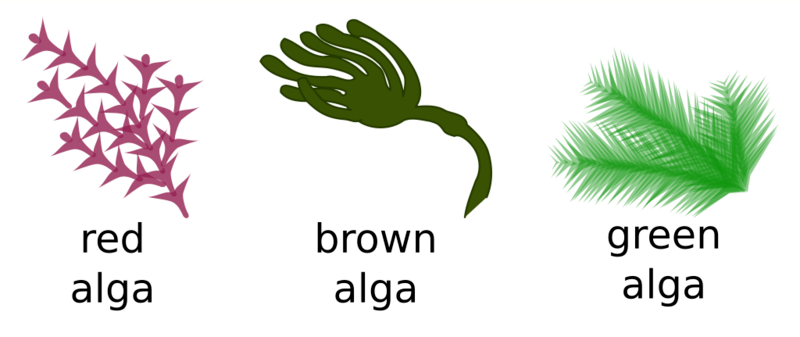
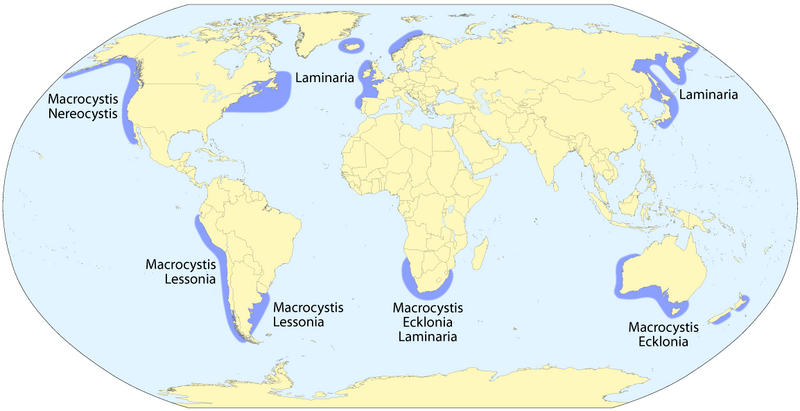
Macroalgae
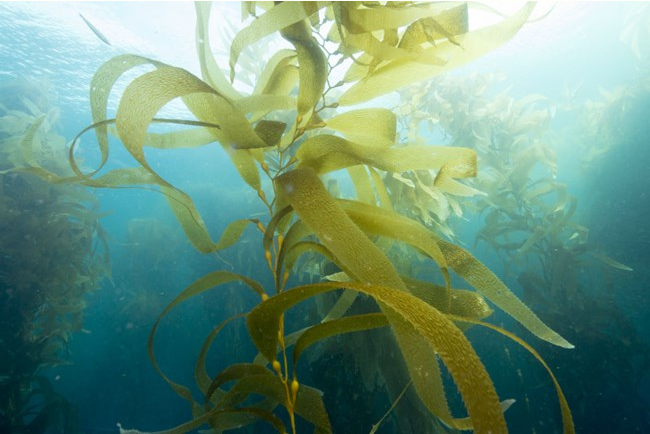
Giant kelp is technically a protist since it is not a true plant, yet it is multicellular and can grow to 50 m. https://handwiki.org/wiki/index.php?curid=1218175

Sargassum seaweed is a brown alga with air bladders that help it float. https://handwiki.org/wiki/index.php?curid=1677090
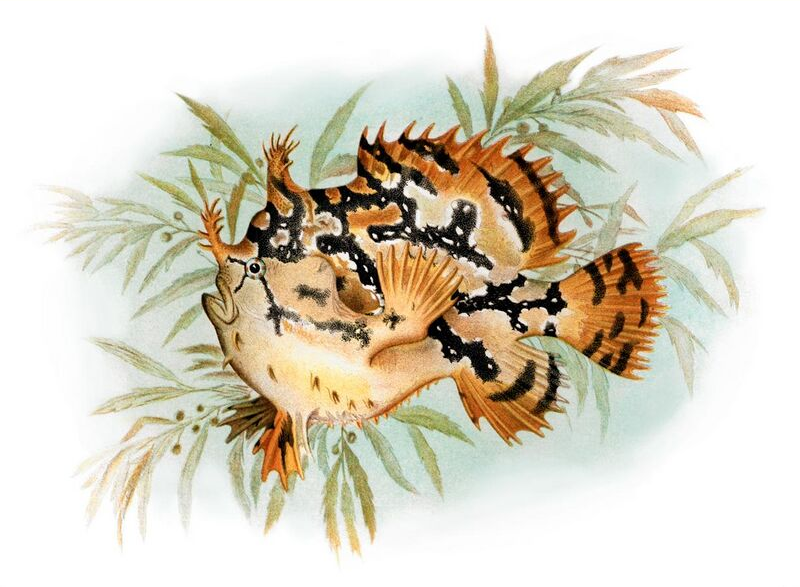
Sargassum fish are camouflaged to live among drifting Sargassum seaweed. https://handwiki.org/wiki/index.php?curid=1609469
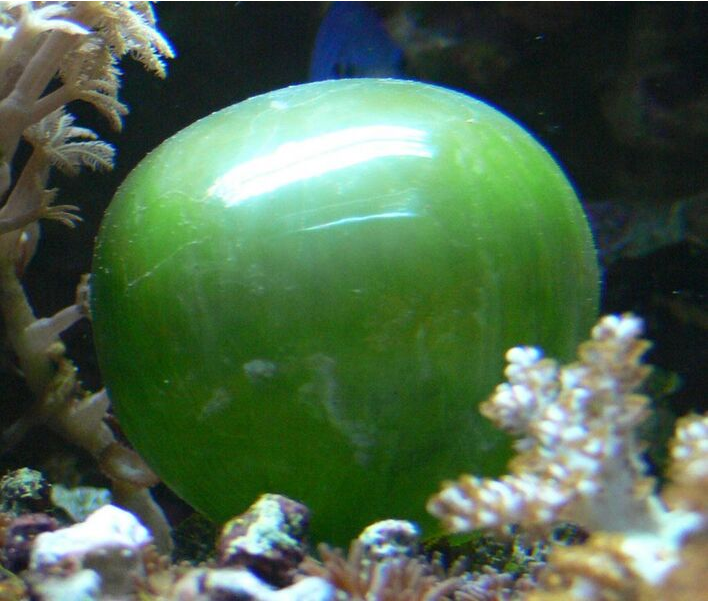
This unicellular bubble algae lives in tidal zones. It can have a 4 cm diameter.[21] https://handwiki.org/wiki/index.php?curid=1666962
3. Marine Plants

Back in the Silurian, some phytoplankton evolved into red, brown and green algae. These algae then invaded the land and started evolving into the land plants we know today. Later, in the Cretaceous, some of these land plants returned to the sea as mangroves and seagrasses.[22]
Marine plants can be found in intertidal zones and shallow waters, such as seagrasses like eelgrass and turtle grass, Thalassia. These plants have adapted to the high salinity of the ocean environment. Plant life can also flourish in the brackish waters of estuaries, where mangroves or cordgrass or beach grass beach grass might grow.
3.1. Mangroves
Mangroves provide important nursery habitats for marine life, acting as hiding and foraging places for larval and juvenile forms of larger fish and invertebrates. Based on satellite data, the total world area of mangrove forests was estimated in 2010 as 134,257 square kilometres (51,837 sq mi).[23][24]
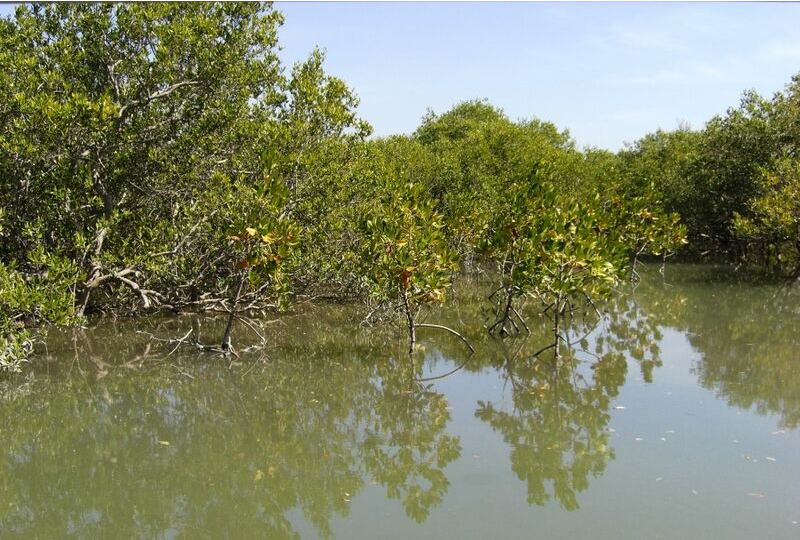
Mangroves https://handwiki.org/wiki/index.php?curid=1735519


Spalding, M. (2010) World atlas of mangroves, Routledge. ISBN 9781849776608. doi:10.4324/9781849776608.
3.2. Seagrasses
Like mangroves, seagrasses provide important nursery habitats for larval and juvenile forms of larger fish and invertebrates. The total world area of seagrass meadows is more difficult to determine than mangrove forests, but was conservatively estimated in 2003 as 177,000 square kilometres (68,000 sq mi).[25]
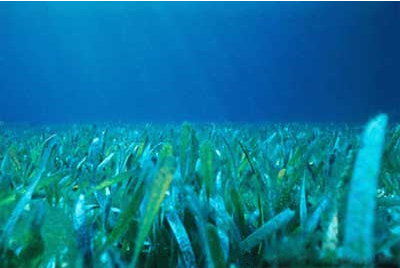
Seagrass meadow. https://handwiki.org/wiki/index.php?curid=1474225

Sea dragons camouflaged to look like floating seaweed live in kelp forests and seagrass meadows[26] https://handwiki.org/wiki/index.php?curid=1089357
References
- Campbell, Neil A.; Reece, Jane B.; Urry, Lisa Andrea; Cain, Michael L.; Wasserman, Steven Alexander; Minorsky, Peter V.; Jackson, Robert Bradley (2008). Biology (8 ed.). San Francisco: Pearson – Benjamin Cummings. ISBN 978-0-321-54325-7.
- McNeill, J., ed (2012). International Code of Nomenclature for algae, fungi, and plants (Melbourne Code), Adopted by the Eighteenth International Botanical Congress Melbourne, Australia, July 2011 (electronic ed.). International Association for Plant Taxonomy. http://www.iapt-taxon.org/nomen/main.php?page=art3. Retrieved 2017-05-14.
- "Cyanobacteria and cyanobacterial toxins". Oceans and Human Health: Risks and Remedies from the Seas. Academic Press. 2 September 2011. ISBN 978-0-08-087782-2. https://books.google.com/books?id=LMZPqW-PmFYC&pg=PA271.
- "The Rise of Oxygen - Astrobiology Magazine" (in en-US). http://www.astrobio.net/news-exclusive/the-rise-of-oxygen/.
- Flannery, D. T.; R.M. Walter (2012). "Archean tufted microbial mats and the Great Oxidation Event: new insights into an ancient problem". Australian Journal of Earth Sciences 59 (1): 1–11. doi:10.1080/08120099.2011.607849. Bibcode: 2012AuJES..59....1F. https://semanticscholar.org/paper/8e2fb3f5ab865aed8faceee53c45558724c13c6c.
- Rothschild, Lynn (September 2003). "Understand the evolutionary mechanisms and environmental limits of life". NASA. Archived from the original on 11 March 2012. https://www.webcitation.org/664nY11q7?url=http://astrobiology.arc.nasa.gov/roadmap/g5.html. Retrieved 13 July 2009.
- "The cells that rule the seas". Scientific American 289 (6): 52–3. December 2003. doi:10.1038/scientificamerican1203-52. PMID 14631732. Bibcode: 2003SciAm.289f..52N. http://guowei.ccps.tp.edu.tw/nc/UploadDocument/255_02%20The%20Cells%20that%20Rules%20the%20Sea.pdf.
- "The Most Important Microbe You've Never Heard Of". https://www.npr.org/templates/story/story.php?storyId=91448837.
- Flombaum, P.; Gallegos, J. L.; Gordillo, R. A.; Rincon, J.; Zabala, L. L.; Jiao, N.; Karl, D. M.; Li, W. K. W. et al. (2013). "Present and future global distributions of the marine Cyanobacteria Prochlorococcus and Synechococcus". Proceedings of the National Academy of Sciences 110 (24): 9824–9829. doi:10.1073/pnas.1307701110. PMID 23703908. http://www.pubmedcentral.nih.gov/articlerender.fcgi?tool=pmcentrez&artid=3683724
- Nabors, Murray W. (2004). Introduction to Botany. San Francisco, CA: Pearson Education, Inc. ISBN 978-0-8053-4416-5.
- Allaby, M., ed (1992). "Algae". The Concise Dictionary of Botany. Oxford: Oxford University Press.
- "How many species of algae are there?". Journal of Phycology 48 (5): 1057–63. October 2012. doi:10.1111/j.1529-8817.2012.01222.x. PMID 27011267. https://semanticscholar.org/paper/27efb217aa66823b850686a2016c68cb69fdd584.
- Guiry, M.D.; Guiry, G.M. (2016). "Algaebase". http://www.algaebase.org/browse/taxonomy/?id=97240.
- D. Thomas (2002). Seaweeds. Life Series. Natural History Museum, London. ISBN 978-0-565-09175-0.
- Hoek, Christiaan; den Hoeck, Hoeck Van; Mann, David; Jahns, H.M. (1995). Algae : an introduction to phycology. Cambridge University Press. p. 166. ISBN 9780521316873. OCLC 443576944. https://books.google.com/books?id=s1P855ZWc0kC&pg=166.
- The Air You're Breathing? A Diatom Made That https://www.livescience.com/46250-teasing-apart-the-diatom-genome.html
- "More on Diatoms". http://www.ucmp.berkeley.edu/chromista/diatoms/diatommm.html.
- Starckx, Senne (31 October 2012) A place in the sun - Algae is the crop of the future, according to researchers in Geel Flanders Today, Retrieved 8 December 2012 http://www.flanderstoday.eu/current-affairs/place-sun
- Kelp Forest - an overview | ScienceDirect Topics https://www.sciencedirect.com/topics/earth-and-planetary-sciences/kelp-forest
- Mann, K.H. 1973. Seaweeds: their productivity and strategy for growth. Science 182: 975-981.
- Tunnell, John Wesley; Chávez, Ernesto A.; Withers, Kim (2007). Coral reefs of the southern Gulf of Mexico. Texas A&M University Press. p. 91. ISBN 978-1-58544-617-9. https://books.google.com/books?id=tu0sqBp8eAAC&pg=PA91.
- Orth, R.J., Carruthers, T.J., Dennison, W.C., Duarte, C.M., Fourqurean, J.W., Heck, K.L., Hughes, A.R., Kendrick, G.A., Kenworthy, W.J., Olyarnik, S. and Short, F.T. (2006) "A global crisis for seagrass ecosystems". Bioscience, 56(12): pages 987–996. doi:10.1641/0006-3568(2006)56[987:AGCFSE]2.0.CO;2 https://academic.oup.com/bioscience/article/56/12/987/221654
- Giri C, Ochieng E, Tieszen LL, Zhu Z, Singh A, Loveland T, et al. (2011) "Status and distribution of mangrove forests of the world using earth observation satellite data". Global Ecology and Biogeography, 20(1):154–159. doi:10.1111/j.1466-8238.2010.00584.x https://doi.org/10.1111%2Fj.1466-8238.2010.00584.x
- Thomas, N., Lucas, R., Bunting, P., Hardy, A., Rosenqvist, A. and Simard, M. (2017) "Distribution and drivers of global mangrove forest change, 1996–2010". PLOS ONE, 12(6): e0179302. doi:10.1371/journal.pone.0179302 https://doi.org/10.1371%2Fjournal.pone.0179302
- Short, F.T. and Frederick, T. (2003) World atlas of seagrasses, University of California Press, page 24. ISBN:9780520240476 https://www.unep-wcmc.org/resources-and-data/world-atlas-of-seagrasses
- Froese, Rainer and Pauly, Daniel, eds. (2009). "Phycodurus eques" in FishBase. July 2009 version. http://www.fishbase.org/summary/SpeciesSummary.php?genusname=Phycodurus&speciesname=eques




